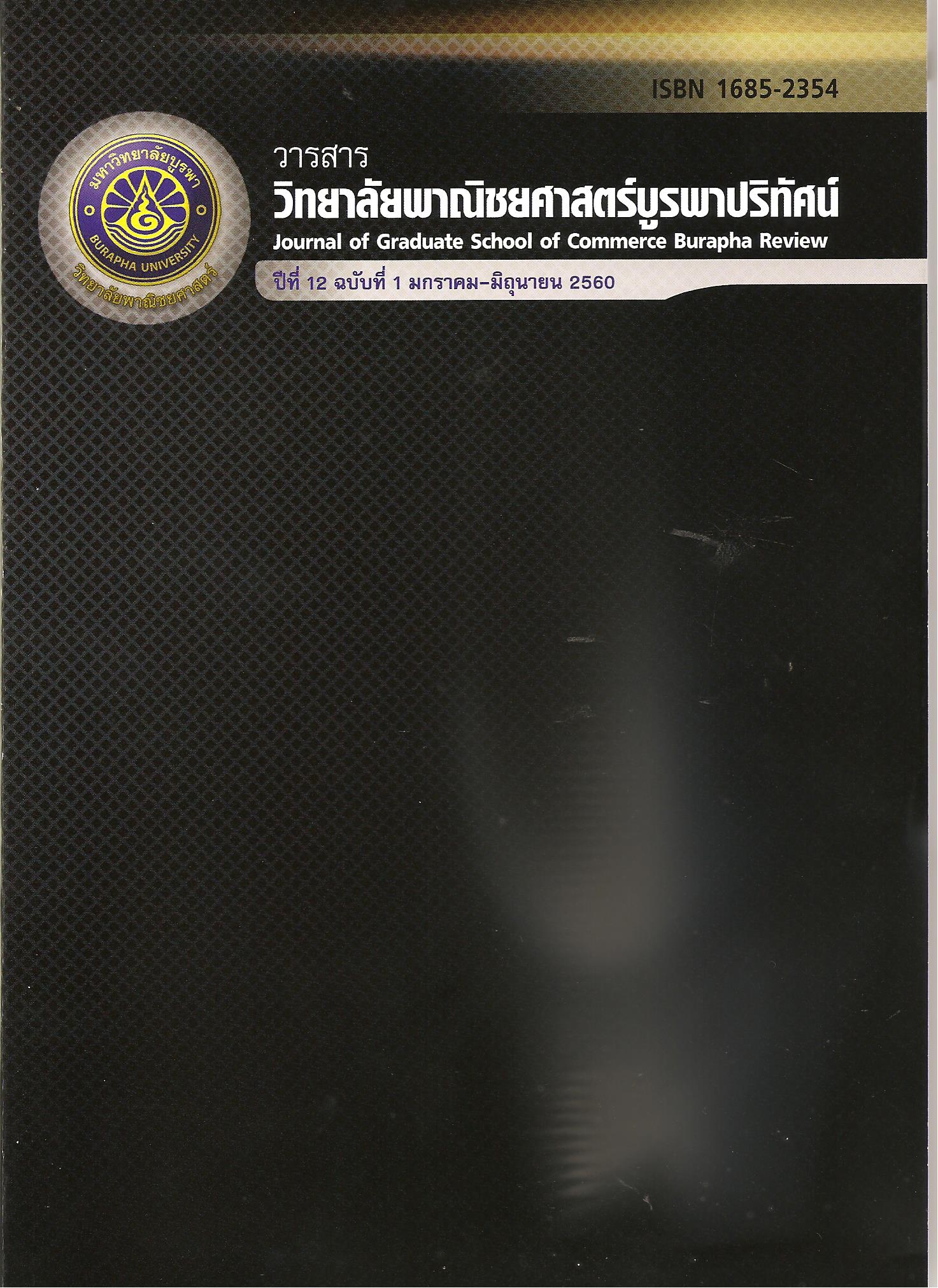การสังเคราะห์องค์ประกอบปรัชญาของเศรษฐกิจพอเพียงไปปฏิบัติจริงในการพัฒนาธุรกิจ
Main Article Content
Abstract
บทคัดย่อ
การวิจัยนี้มีวัตถุประสงค์เพื่อค้นหาปัจจัยที่เหมาะสมในการกำหนดเป็นรูปแบบ และนำไปทดลองใช้กับกลุ่มตัวอย่าง พัฒนาเป็นเครื่องมือสำหรับพิสูจน์ทฤษฎีกับกลุ่มตัวอย่างอื่นต่อไป การวิจัยครั้งนี้เป็นการวิจัยเชิงคุณภาพ ใช้รูปแบบการวิจัยเชิงปฏิบัติการแบบมีส่วนร่วม (PAR) ดำเนินการวิจัยโดยการทบทวนวรรณกรรม ศึกษาดูงานหมู่บ้านต้นแบบเศรษฐกิจพอเพียง นำองค์ประกอบ 3 ห่วง 2 เงื่อนไข ในปรัชญาของเศรษฐกิจพอเพียงที่ถูกนำมาใช้กับมาสังเคราะห์เป็นตัวแปร เพื่อนำไปใช้ทดสอบกับกลุ่มตัวอย่าง 2 กลุ่ม จำนวน 14 คน ได้มาโดยการเลือกแบบเฉพาะเจาะจง เครื่องมือที่ใช้ในการวิจัย ได้แก่ แบบสอบถาม แบบสังเกต แบบสัมภาษณ์ และแบบบันทึกการประชุมกลุ่มย่อย
ผลการวิจัยพบว่า การสังเคราะห์ตัวแปรย่อยจากองค์ประกอบ 3 ห่วง 2 เงื่อนไข ในปรัชญาของเศรษฐกิจพอเพียงที่ได้จากการทบทวนวรรณกรรมทั้งสิ้น 35 ตัวแปร และตัวแปรย่อยจากการศึกษาดูงานหมู่บ้านเศรษฐกิจพอเพียงทั้งสิ้น 26 ตัวแปร รวมทั้งสิ้น 61 ตัวแปร นำมาทดลองใช้กับกลุ่มตัวอย่าง ปรากฏผลดังนี้ ด้านความรู้ พบว่า การเน้นความเป็นจริงในอาชีพ มีองค์ความรู้หลากหลายมากกว่าอาชีพที่ทำ และมีความรู้ว่าลูกค้าต้องการสินค้าและบริการอะไร ด้านคุณธรรม รู้ รัก สามัคคี และซื่อตรง ไม่โลภ ไม่เบียดเบียน ด้านการมีเหตุผล มีความเด็ดเดี่ยวในการตัดสินใจ และมีการพัฒนาความคิด จิตใจในการดำรงชีพตลอดเวลา ด้านการมีภูมิคุ้มกัน มีส่วนร่วมของคนในชุมชนที่ร่วมกันประกอบอาชีพ มีการพัฒนาอาชีพอย่างยั่งยืน และมีการวางแผนการผลิตเป็นขั้นเป็นตอน ด้านความพอประมาณ มีความยินดีในสิ่งที่ทำ
สามารถนำหลักการวางแผน และการบริหารจัดการมาใช้ในการประกอบอาชีพ และมีการแสวงหาวิธีการลดรายจ่ายและไม่ฟุ่มเฟือยในการดำเนินชีวิต โดยตัวแปรย่อยแต่ละตัวมีค่าคะแนนสูงที่สุดเรียงตามลำดับ
ABSTRACT
The objective of this study was to explore factors suitable for determining a model to be used with the samples, as well as to develop into the tool for testing the theory with other sample groups. This qualitative study employed the Participatory Action Research method. The researcher reviewed related literature, visited sufficiency economy model villages, synthesized the three components and the two conditions into variables for experimenting with two groups of 14 samples, selected by purposively sampling method. The research tools included the questionnaire, observation forms, interviews, and small-group meeting records.
The results showed that the synthetic variables of the three components and the two conditions in the Sufficiency Economy of Philosophy. The variables from a literature review 35 variables and from the villages of sufficiency economy 26 variables total 51 variables. The variables were experimenting with the samples ,the results as : Knowledge: The reality in the career, having a wide range of professional and non-professional knowledge, and knowing the customers’ needs for products and services. Ethics: The samples paid attention to knowledge, love, unity, honesty, and being greedless and non-oppression. Reasonableness: The samples were more decisive and had improvement in thoughts and mind in living at all time. Self-Immunity: The sample groups gave values to the participation of people in the community in doing their work, developing career sustainability, and planning their production systematically. Moderation: The samples appreciated what they were doing, were able to use planning and managing concepts in their occupation, searched for methods of reducing expenses, and lived their non-superfluous lives. For the dimensions of sufficiency economy philosophy, business operating behaviors of the samples were found to cover the dimensions of economy, society, psychology, culture, and an additional obvious dimension of learning.
Article Details
The owner of the article does not copy or violate any of its copyright. If any copyright infringement occurs or prosecution, in any case, the Editorial Board is not involved in all the rights to the owner of the article to be performed.

